This is my serialized story of walking the Camino de Santiago across Northern Spain with my sister-in-law. If you’d like to start at the beginning, click here.
Day 12: Today, Marlene, my tenacious sister-in-law, and I will leave behind the small town of Belorado for an even smaller town of Ages. This will be a fifteen-mile hike and a formidable undertaking as our goal is to walk across the Oca Mountains.
Tomorrow, though, we expect to reach Burgos, our first major city since Pamplona. I anticipate wonderful meals, cool cafes, and first-class accommodations when we walk triumphantly into one of Spain’s most historic cities. Marlene, I know, is set on touring its great cathedrals and reminds me we have booked a hostel for only one night. Clearly, to my thinking, we will need to see it all and do it all, all at once - while simultaneously resting and recovering from a second week of walking across Spain.
Pamplona, a week earlier, now seems like a distant memory - Marlene and I were only four days into our pilgrimage and just getting used to each other when we reached the city on that first Friday. After hiking seventeen miles that day we discovered we had arrived at the start of a popular weekend festival. Even so, we were happy to get away from the crowds, find our hostel, and get off our feet. Of course, bumping into fellow pilgrims from the first day of our hike was a welcome surprise and resulted in the group of us enjoying a wonderful dinner at a busy outdoor restaurant that night. Still, I couldn’t help but think not enough time had passed to truly appreciate reaching our first city and meeting, once again, our new Camino friends.
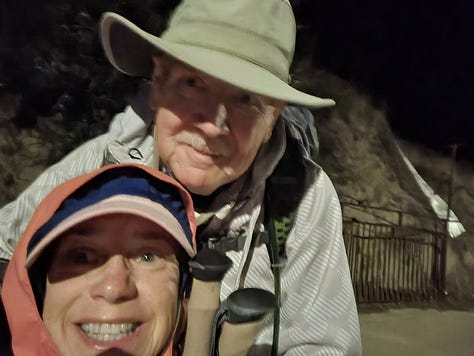
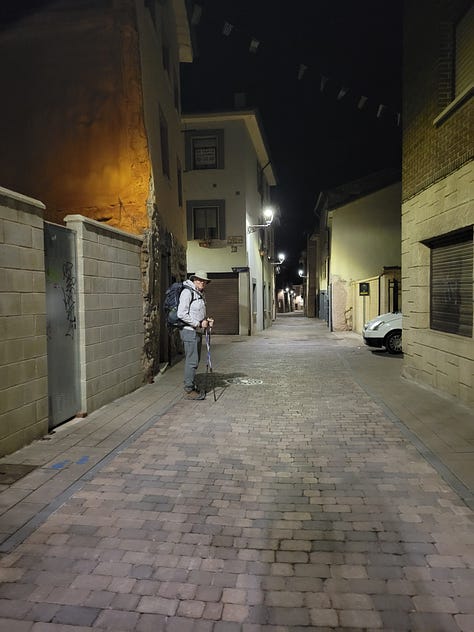



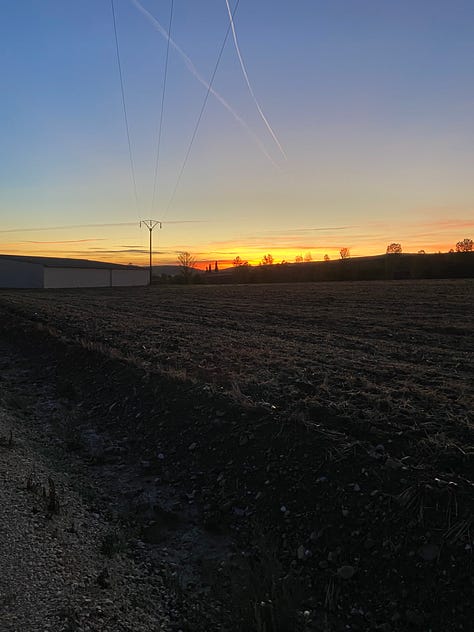
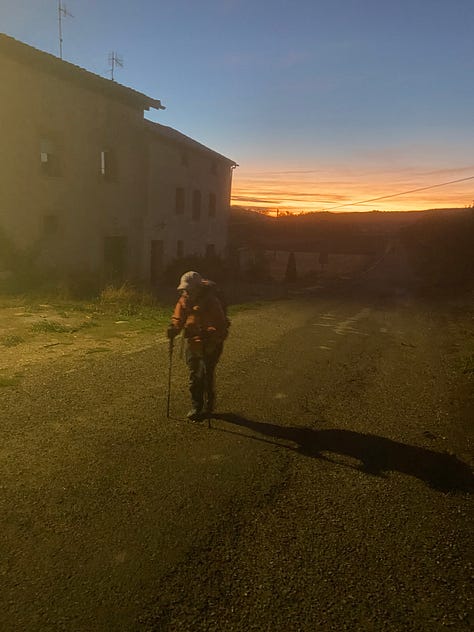
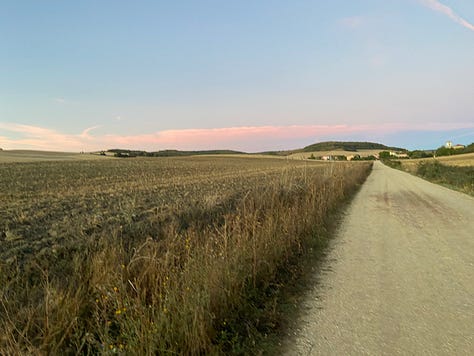
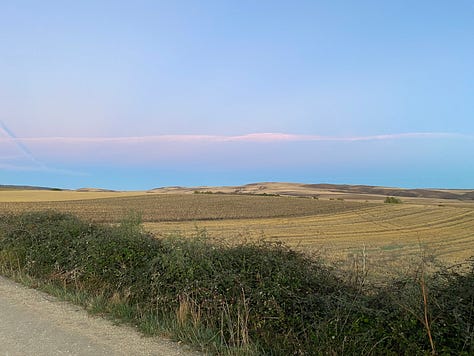
Today, though, we can’t allow ourselves to look ahead to tomorrow. Our hike in the morning will take us through plowed farmland and fields of dead sunflowers (that have yet to be harvested) before we undertake the stiff climb up and over the Oca Mountain range. We haven’t climbed a significant mountain since the Pyrenees and, even though we love the Spanish farmland, we are ready for the mountain forests.
Four miles into our pilgrimage, we stop and eat a quick breakfast at the tiny town of Villambistia and take a couple of pictures. We won’t eat lunch, so we prepare for the day ahead by buying apples and bananas to carry with us.

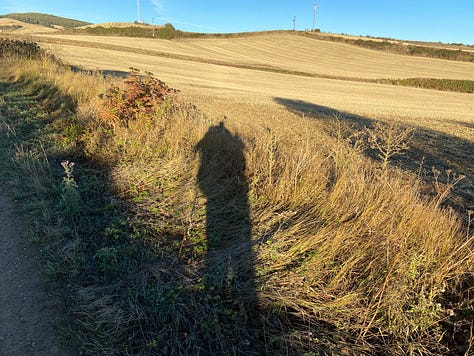
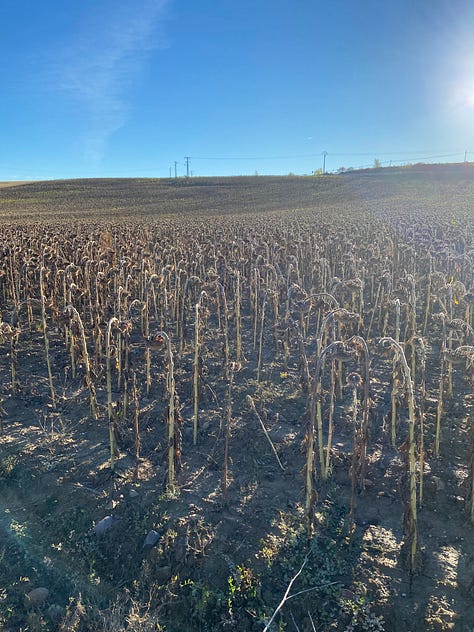

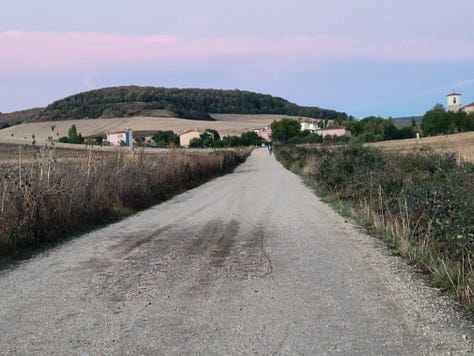

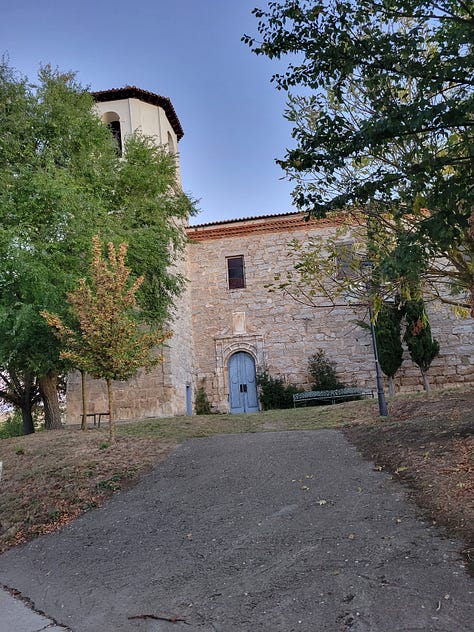
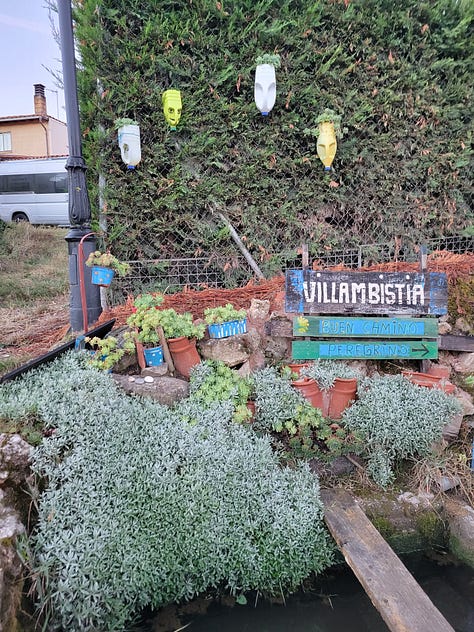
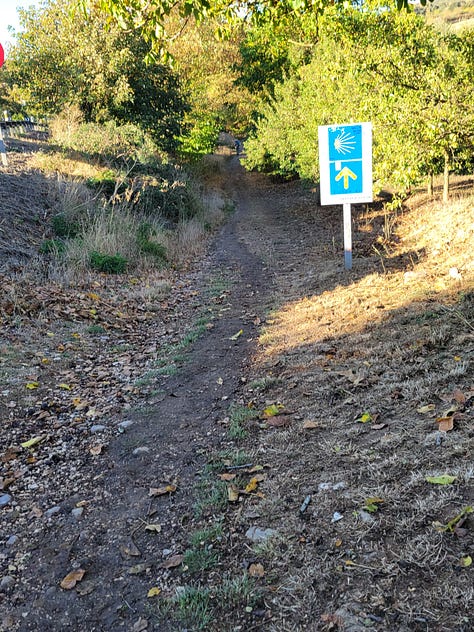
Three miles later we arrive at Villafranca Montes de Oca, the little town at the base of the mountain range. Trucks whiz by us gaining speed to head up the mountain while we sit on a bench outside a busy bar and change our socks in preparation for the climb. The next eight miles will be interesting as the Oca Mountains are notorious in Camino legend for thieves and murderers who centuries ago preyed on pilgrims hiking the mountain pass. More recently, these mountains hid anti-fascist republicans fighting Francisco Franco’s army back at the start of the Spanish Civil War.
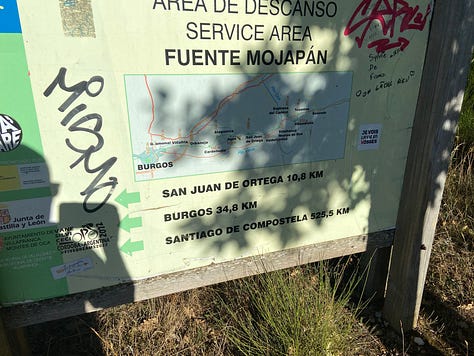
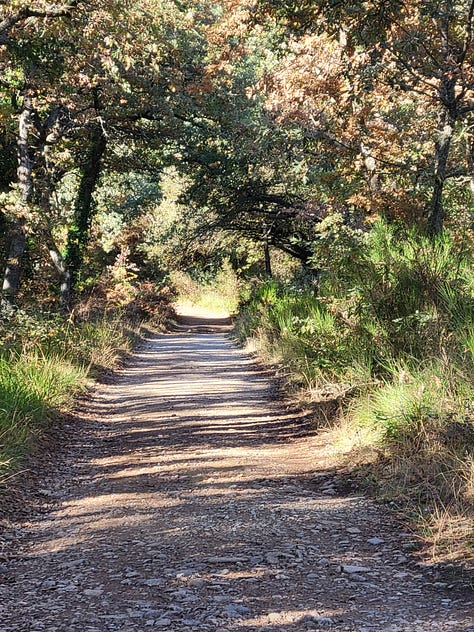

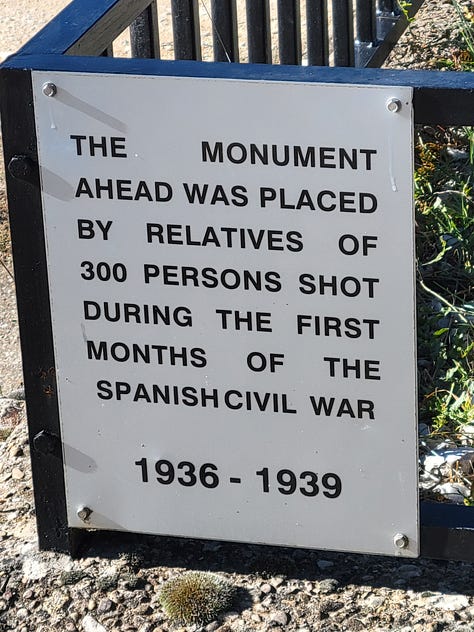
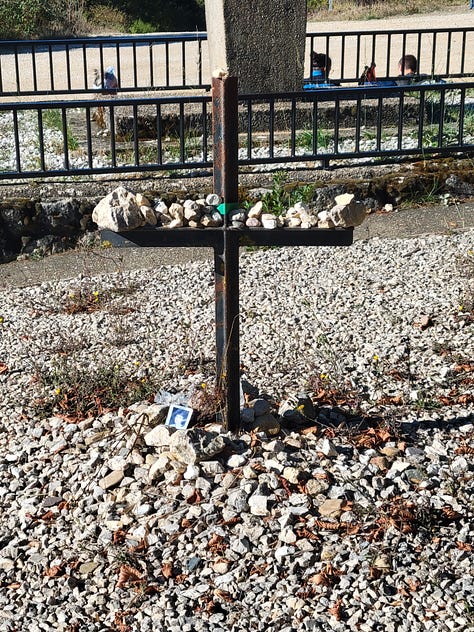
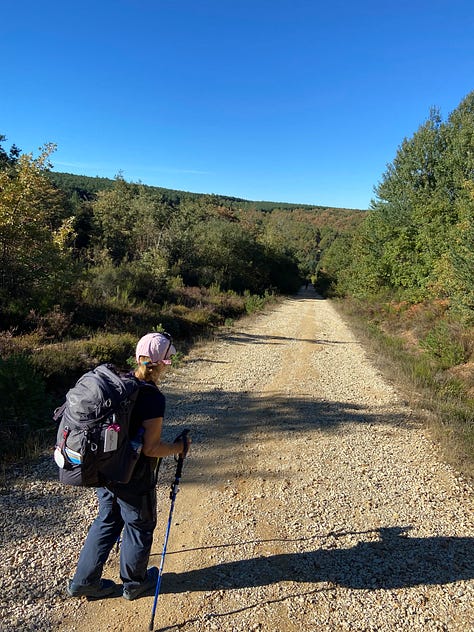


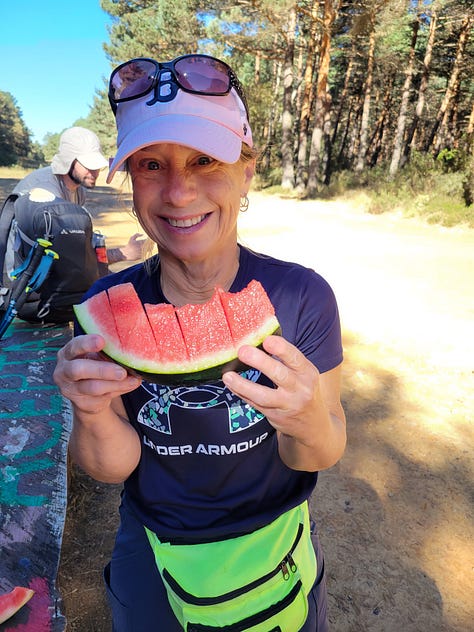
Our hike up the mountain does not follow the highway, but starts ignominiously on a rocky cow path behind the local Catholic church and next to a plowed field. Shortly after climbing past the field, the path turns into a tractor trail that continues upward into thick woods and a series of open vistas showcasing the long mountain ridge line and the small towns in the valleys below. As we hike up each stiff slope, it feels like it should be the final one, like we have reached the top, but each dip or turn only leads to another stiff slope as we climb ever upward for about a half-a-mile.
In the hike I pull away from Marlene who we both have come to realize over the previous eleven days climbs slower than me. She doesn’t mind me going at my pace, while she goes hers. She calls me “The Beast” because of how fast I walk, especially up hills, a nomenclature I am not sure I like, but she tells everyone we meet along the way I am a “beast” and I suppose I am - at least, I feel like it’s a challenge.
In this hike up the mountain pass I can feel the presence of another hiker who is slowly gaining on me. I use the sound of his sticks and breathing to stay motivated and push myself to remain in front of him. I don’t look back, but am happy forty minutes later to reach the top of the mountain. I stop at the open area in the woods and turn to the man behind me. He’s big, six-feet or so, heavy-set but solid. He nods as he walks past, but continues on his journey. I feel like raising my fists high in celebration as I turn to look back for Marlene. Instead I notice a number of young hikers sitting at the base of a monument erected on the side of the site.
The memorial, known as the Monumento de los Caidos, is a sobering granite column commemorating an incident at the start of the Spanish Civil War where three hundred men in the surrounding area were executed at this spot and buried in a mass grave by members of Franco’s army. This is our second memorial in recognizing people executed by Franco during the Civil War. (Our first coming out of Pamplona on the Alto del Perdon.) You can’t help but realize how horrible it must have been in this region of Spain in the 1930s.
The group of seven-or-so young hikers sitting at the monument are laughing and joking around with each other, ignoring completely the memorial rising above them and why it was resurrected. I sit down at a picnic table across the grassy clearing from the stone column and eat an apple, watching the revelers while waiting for Marlene. I can’t help but feel discombobulated. A sense of two worlds clashing: one fades from memory while another, less solemn, takes it place. The hikers are without a care or concern about what this memorial represents and, perhaps, how easily things could change - just as it changed a generation or two earlier. I realize, then, I should include myself, as I raced up the mountain, like I was in a marathon, to beat a fellow pilgrim, not giving thought to what had taken place on this mountain for centuries or, even now, without striving to find peace and acceptance in the scene unfolding.
Marlene arrives and takes pictures. She hears my rant about the hikers, but offers her advice that I continually fail to learn: “Everyone walks their own Camino.”
Soon we are on our way to complete the next seven-and-a-half miles across the Oca Mountain range. But the path through the forest turns into a three-lane swath of bulldozed, dried mud - the government either has created an extensive fire break or is engaged in sinking a pipeline across the mountain or both. Still, this part of the walk isn’t nearly as scenic as the hike up and this is disappointing. Before we come off the mountain, though, we reach a small fruit stand a local couple have set up and Marlene is delighted to find watermelon. This, to me, is a nice gesture by some locals on an otherwise long, brown, mountainous gash.
On reaching the sanctuary of San Juan de Ortega at the bottom of the Oca Mountain, our hike for the day is nearly over. A tour of the church and a couple of orange sodas are a nice reprieve before we leave the Camino. We have learned that there are no beds available in Ages, as too many pilgrims coming off the pass are overwhelming the small town. Our plan now is to walk two miles on an alternative route to the equally small town of Santovenia de Oca, where we were able to reserve two beds in a dormitory-style hostel. Before the afternoon is out, this hostel too will be filled with other pilgrims, like us, who couldn’t find accommodations at Ages.
In many ways, this hostel we are in, a renovated building with outdoor seating and a bar on the corner of a farm-town square, seems very new. The second floor has two large dormitory rooms, each holding fifteen beds, with men and women’s bathrooms (with seven showers in each) between the dorms. It almost feels like the Spanish government is helping to subsidize anyone willing to establish a hostel in areas where additional beds are desperately needed. Ages, on the Camino, is famous for being totally overwhelmed by pilgrims each year. Perhaps the government is on a quest to spread the hikers out in this remote area.
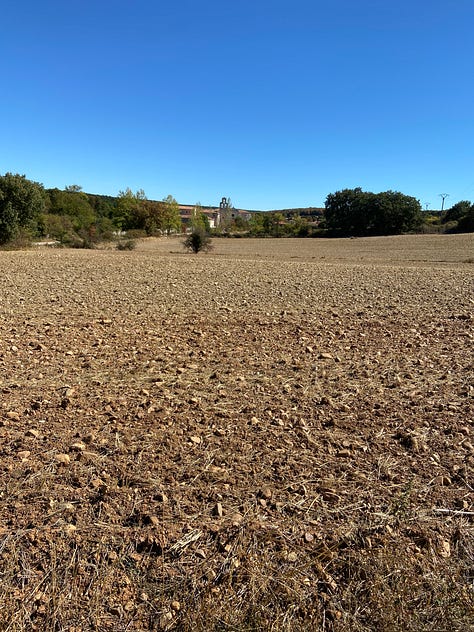
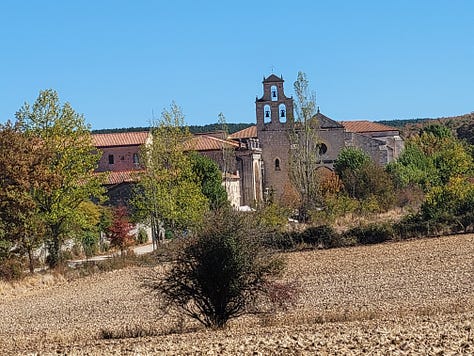
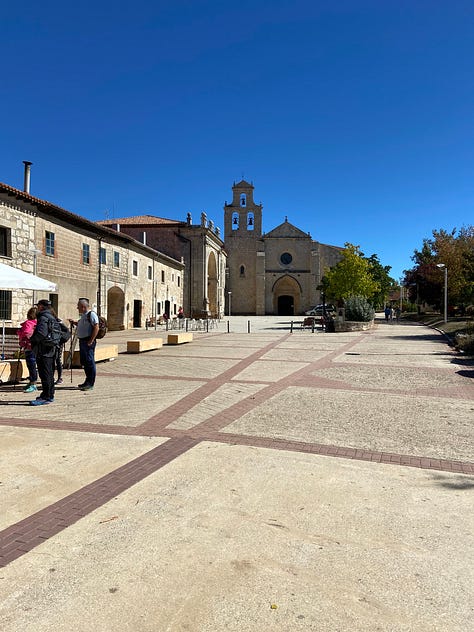


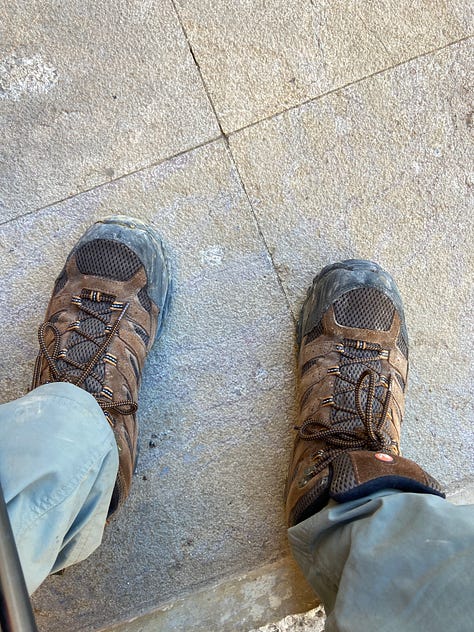

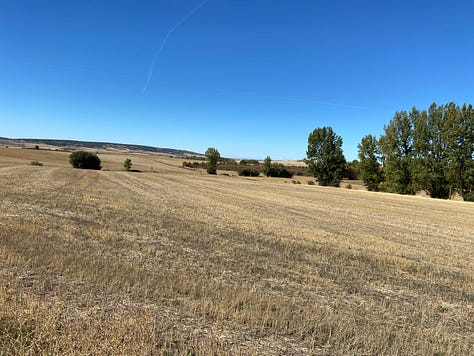

As we sit outside the hostel in the late afternoon, we meet a hiker from Croatia, who, I realize, is the man that hiked up the Orca Mountain behind me. He says, “Damn, you are a hard man to catch.” Marlene tells him my trail name and he agrees. His name is Emanuel and he and Marlene, it turns out, get along fabulously; he shows us pictures of his family and invites Marlene and her family to visit him in Dubrovnik.
Later that evening, we meet a large group of Christian pilgrims from Singapore who, like us, are hiking across Spain before their tour takes them to Barcelona. Others in the dormitory are from Germany and France and even, the United States - including a girl named Cristina from Charlotte, North Carolina, who goes to college in Chapel Hill. This, too, like earlier today, comes with a sense of discombobulation. I may be “The Beast” on the Camino, but, at the same time, I am simply a retiree from Durham, only ten miles from Chapel Hill. I am here, I remind myself, to learn serenity with my kind and open-hearted sister-in-law as we walk across Spain.
Blessed are you, pilgrim, if on the way you meet yourself and give yourself time without haste so as not to neglect your heart.




Jonathan aka the Camino Beast is a term of endearment to one of the strongest pilgrims on the Camino Frances. You are so formidable on the ascents. I read this chapter to Austin and Tenley and they said, "Wow", Uncle Jonathan is a really good writer. I Agee ❤️ Thanks.